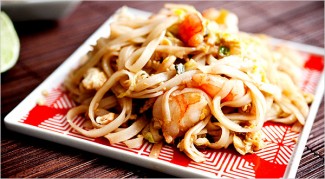Pad Thai, an Easy Stir-Fry

IN the last 20 years or so, pad Thai has gone from being virtually unknown in this country to being a restaurant and takeout staple. It’s easy to see why: the tangy, crunchy, slightly sweet noodles are irresistible. But it’s difficult to understand why more people don’t make it at home, since pad Thai is essentially a stir-fry (in Thailand they refer to it as a Chinese noodle dish). It requires little more than chopping and stirring, and comes together in less than a half-hour.
A couple of components might be unfamiliar to you. The first are the noodles themselves: rice stick noodles, which are pale, translucent, flat and range from very thin to more than a quarter-inch wide. Unlike semolina pasta, rice stick noodles don’t need to be boiled; instead, you soak them in hot water until they’re tender.
Meanwhile, make a sauce from tamarind paste, easily found these days. The paste, made from the pulp of the tamarind pod, is very sour, but more complex than citrus. Fish sauce (nam pla) is another important ingredient; made from fermented anchovies (and much like the garum of ancient Rome), it has an unappealing smell and a fabulous taste. Honey and rice vinegar round things out.
Other ingredients are pretty flexible: bean sprouts are usual and cabbage is nice, but other vegetables are perfectly acceptable. As for protein, shrimp and tofu are the most common combination, but you could also use chicken, or just another egg.
When the noodles have soaked and the sauce is assembled, all that remains is stir-frying, so easy and fast that pad Thai could become a from-scratch favorite.
4 ounces fettuccine-width rice stick noodles
1/4 cup peanut oil
2 to 4 tablespoons tamarind paste
1/4 cup fish sauce (nam pla)
1/3 cup honey
2 tablespoons rice vinegar
1/2 teaspoon red pepper flakes, or to taste
1/4 cup chopped scallions
1 garlic clove, minced
2 eggs
1 small head Napa cabbage, shredded (about 4 cups)
1 cup mung bean sprouts
1/2 pound peeled shrimp, pressed tofu or a combination
1/2 cup roasted peanuts, chopped
1/4 cup chopped fresh cilantro
2 limes, quartered.
1. Put noodles in a large bowl and add boiling water to cover. Let sit until noodles are just tender; check every 5 minutes or so to make sure they do not get too soft. Drain, drizzle with one tablespoon peanut oil to keep from sticking and set aside. Meanwhile, put tamarind paste, fish sauce, honey and vinegar in a small saucepan over medium-low heat and bring just to a simmer. Stir in red pepper flakes and set aside.
2. Put remaining 3 tablespoons oil in a large skillet over medium-high heat; when oil shimmers, add scallions and garlic and cook for about a minute. Add eggs to pan; once they begin to set, scramble them until just done. Add cabbage and bean sprouts and continue to cook until cabbage begins to wilt, then add shrimp or tofu (or both).
3. When shrimp begin to turn pink and tofu begins to brown, add drained noodles to pan along with sauce. Toss everything together to coat with tamarind sauce and combine well. When noodles are warmed through, serve, sprinkling each dish with peanuts and garnishing with cilantro and lime wedges.
None Available.